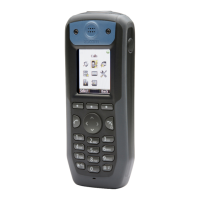In figure 6, a message with priority 2 is received at 13:59 and is displayed in the handset.
Another message with equal priority is received at 14:02 and is placed in the queue. If no
messages with higher priority are received, the user needs to close the current displayed
message to show the next message in the queue. In this case, the message received at
14:02. The closed message is indicated as a read message in the Messaging Inbox.
Example 2
This example describes the message handling with
the following message settings:
• TTP= 20 seconds
• TTR= Close manually
Tip: It is recomm
ended to use these settings if the user is not to be interrupted during 20
seconds while reading a message, unless a message with higher priority is received. When
the user has read a message, its priority is no longer important, that is when TTP expires.
Figure 7. Priority Queue Messaging with PTT 20
Prio 2
TTP started
Prio 2
New messages
Prio 1
TTP started
M
es
sag
e
que
ue
10 sec.
Prio 2
TTP paused
Prio 2
TTP
continues
M
es
sag
e
que
ue
20 sec.
Prio 1
TTP expired
Prio 1
TTP expired
Message que
u
e
10 sec.
Prio 2
TTP expired
Prio 1
New messages
In figure 7, a message with priority 2 is received and displayed in the handset, TTP for the
message is started.
After 10 seconds, a second message with priority 1 is received and displayed while the
message with priority 2 is put in the queue. TTP for the message with priority 2 is paused,
and TTP for the message with priority 1 is started.
After 20 seconds, TTP expires for the message with priority 1 and the message is placed in
the queue. The message with priority 2 is shown again and its TTP continues.

